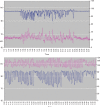Improving detection of patient deterioration in the general hospital ward environment
- PMID: 29474347
- PMCID: PMC5902137
- DOI: 10.1097/EJA.0000000000000798
Improving detection of patient deterioration in the general hospital ward environment
Abstract
: Patient monitoring on low acuity general hospital wards is currently based largely on intermittent observations and measurements of simple variables, such as blood pressure and temperature, by nursing staff. Often several hours can pass between such measurements and patient deterioration can go unnoticed. Moreover, the integration and interpretation of the information gleaned through these measurements remains highly dependent on clinical judgement. More intensive monitoring, which is commonly used in peri-operative and intensive care settings, is more likely to lead to the early identification of patients who are developing complications than is intermittent monitoring. Early identification can trigger appropriate management, thereby reducing the need for higher acuity care, reducing hospital lengths of stay and admission costs and even, at times, improving survival. However, this degree of monitoring has thus far been considered largely inappropriate for general hospital ward settings due to device costs and the need for staff expertise in data interpretation. In this review, we discuss some developing options to improve patient monitoring and thus detection of deterioration in low acuity general hospital wards.
Figures




References
-
- Smith GB. In-hospital cardiac arrest: is it time for an in-hospital ’chain of prevention’? Resuscitation 2010; 81:1209–1211. - PubMed
-
- Ghaferi AA, Birkmeyer JD, Dimick JB. Variation in hospital mortality associated with inpatient surgery. N Engl J Med 2009; 361:1368–1375. - PubMed
-
- Sinha S, Ata OB, Khalid U, et al. Failure-to-rescue and interprovider comparisons after elective abdominal aortic aneurysm repair. Br J Surg 2014; 101:1541–1550. - PubMed
-
- Silber JH, Romano PS, Rosen AK, et al. Failure-to-rescue: comparing definitions to measure quality of care. Med Care 2007; 45:918–925. - PubMed
Publication types
MeSH terms
Grants and funding
LinkOut - more resources
Full Text Sources
Other Literature Sources

